A detailed look at Cal Baseball alum Andrew Vaughn's MLB rookie season so far
Vaughn is on verge of graduating off the prospect list (130 ABs threshold)
Thanks partly to his good plate discipline, Cal Baseball superstar Andrew Vaughn’s MLB career only includes 116 at-bats (ABs) thus far despite 136 plate appearances. By the end of this week, Vaughn should surpass the 130 AB threshold which means graduation off the baseball prospect lists. Thus, now is the perfect time to take our first in-depth breakdown of his still brief MLB career. It helps that Vaughn appears to be at the start of a hot streak, hitting a dramatic game-tying homer off one of the toughest closers and hardest throwing humans in Aroldis Chapman on Sunday before hitting a lead-changing homer on a nationally televised game on Monday.
Before we dive further into Andrew Vaughn’s stats (at the end of Tuesday, May 25th), I will use this platform to sing some praises on the still relatively new technology that has provided richer baseball data. Since 2015, all 30 MLB stadiums now possess the StatCast technology that provides both accurate and real-time measurements of what is going on on the field - from not just how fast but also the movement and spin rate of pitched balls to the vector (both the speed and direction) of batted balls. Since this article is about Andrew Vaughn, I will mostly discuss the results of his contacts - which is quantified by “exit velocity” AKA how fast the ball is coming off the bat and “launch angle” AKA the angle relative to the ground where the ball will travel. With these two numbers, one can figure out just how far the ball will travel using freshman physics kinematics (even though the ball trajectory while still in the field of play is also measured). The lack of radial angle both simplifies things but also takes away how hitting the balls down the line is often better than hitting it to centerfield, due to the dimension of most ballparks. Nonetheless, there are now enough data that every exit velocity and launch angle pair has an xBA, expected batting average, based on historical outcomes of similarly hit balls (disregarding stuff like shifts or ballpark dimensions). While harder hit balls generally correlate with higher xBAs, one will also see a high xBA for some combination of weakly hit balls for the swinging bunts or bloopers. Fans can now better quantify their team’s bad luck scientifically.
As Sabermetrics evolved, the limitations of the old box scores have been more and more prevalent. The extra information from these past 6+ years has already changed the ways not just how players are valued but how they can be trained to boost productivity. Thanks to websites like Baseball Savant, regular fans have access to a treasure trove of information on what had happened on the field beyond just whether the batter is safe or out. I hope you also find the following data on Andrew Vaughn’s performances to be as interesting as I did.
Andrew Vaughn at Cal
When the Chicago White Sox selected the 2018 Golden Spikes (Baseball’s Heisman) winner Andrew Vaughn out of Cal in the 2019 MLB Draft with the 3rd overall pick, they knew they got one of the best hitters in collegiate baseball history. Yet Vaughn was not a highly regarded recruit out of Maria Carrillo High Schoo in Santa Rosa, CA. He was undrafted by the MLB teams and only hit one home run in high school.
Vaughn’s homerun hitting prowess started right after he stepped foot in Berkeley. In his freshman year in 2017, Vaughn hit 12 homers to lead the Pac-12. He slashed a robust .349/.414/.555 line (batting average/on-base percentage/slugging percentage). In addition to playing 1st base, Vaughn also pitched in 9 games (1 in 2018 and 0 in 2019).
Andrew Vaughn followed that successful 1st season up with a historic season that ended with him winning the Golden Spikes Award. Vaughn slashed a Barry Bonds-esque .402/.531/.819 while hitting 23 homers (for reference, Bond’s 73 homer season slash line was .328/.515/.863). He concluded his Cal career with a strong .374/.539/.704 junior season where he still managed to hit 15 homers even when no team would pitch to him (note the higher OBP due to the Cal single-season record 60 walks). Vaughn concluded his Cal career with 50 homers, good for second all-time in just 3 seasons.
For his collegiate career, Andrew Vaughn hit .374/.495/.688 and established himself as a “can’t miss” baseball hitting prospect. Even when baseball teams generally avoid drafting 1st baseman, much less a right-handed 1st baseman, high in drafts, the White Sox still happily used their 3rd overall pick to add Vaughn.
Andrew Vaughn in MLB
When the Chicago White Sox opted to not resign slugger Edwin Encarnacion in the 2020-21 offseason, they made it clear that Andrew Vaughn will be a big part of the 2021 team for a young but talented squad that has high ambition. While Vaughn was slated to be the regular DH, a late spring training freak injury to Eloy Jimenez that will likely cost the young slugger the entire 2021 season meant that Vaughn will need to play left field, despite little to no experience with that position.
Andrew Vaughn made his MLB debut on April 2nd (a day shy of his 23rd birthday) as the starting left-fielder. With the extremely old-school (and just plain old) Tony La Russa as his manager, Vaughn bat 7th in the lineup and is regularly pulled late for a defensive replacement (for the no-longer that speedy Billy Hamilton, when he is healthy). Injuries on the White Sox have allowed Vaughn to also play some 1st base and right field. The surprising emergence of fellow rookie Yermen Mercedes (most famous for hitting a homer off a position player on a 3-0 count) both took away the DH ABs but also the pressure on Vaughn to produce.
After starting his season 0 for 9, Vaughn got a loud 1st base hit - a ringing double to the opposite field.
Vaughn did not hit his first MLB home run until May 12th, a majestic 436-footer off Twins' Starter J.A. Happ in his home ballpark, Guaranteed Rate Field.
Through 36 games and 113 MLB ABs, Andrew Vaughn is currently hitting .230/.326/.416 with 4 homers (although that number just doubled over the past 3 days). StatCast stats showed a more promising start to Vaughn’s Big League career, however.
Vaughn’s spread shot (on the right) reinforced his reputation of being an advanced hitter who uses the whole field. In addition to hitting singles to all fields, Vaughn also has power to all fields (even if more home runs have gone to left field).
The useful but busy chart on the left compares Andrew Vaughn to all MLB players1. In a direct opposite color scheme than what I would use, red is good and blue is bad. Andrew Vaughn has elite maximum exit velocity and very high average exit velocity, hard-hit percentage, and “barrel” percentage. In layman’s words, Vaughn hits the ball very hard. Surely one can also figure this out via the “eye test”, but here are some quantifiable numbers of just how hard Vaughn consistently hit the balls.
“Barrel” is defined as “a batted ball with the perfect combination of exit velocity and launch angle”, which you can also see in the diagram below. Vaughn has 10 barrels on 80 batted balls. That 12.5% barrel rate is very good if he can sustain it (for comparison, Vladimir Guerrero Jr., the current MLB home run leader at the time of writing, has a 15.8% barrel rate). Vaughn’s solid contact is also evident by the Hard Hit (batted ball with an exit velocity of at least 95 mph) and Sweet Spot (only looking at the ideal launch angle of between 8 and 32 degrees) numbers. Comparing the two, one see that Vaughn is hitting the ball hard almost 50% of the time but could improve his launch angle (it is only good less than 40% of the time and has an average of just 7.1 degrees).
For all MLB players with 50 batted ball events, Vaughn is 48th overall in Average Exit Velocity, 56th in Hard-hit %, and 49th in Barrel/Batted Ball Event.
Comparing his actual slash line to the expected slash line, it is clear that luck has not been on his side (especially on the hard-hit ball that turned into a triple play turned by the Yankees last Friday: 101.1 mph Exit Velocity with an xBA of 0.260 due to a -8 degree launch angle), although these numbers are much closer this week than last week due to his recent heroics.
Vaughn’s actual slash line: .230/.326/.416 for BA/OBP/SLG
Vaughn’s expected slash line: .242/.348/.462 for xBA/xwOBA2/xSLG
More interesting (especially when there are even more data later this season) from Baseball Savant is data on pitch type and locations. Check out Vaughn’s pitch heatmap - the location of all the MLB pitches that he has seen.
Low and away is clearly a place where pitchers go to get Vaughn to chase. A quarter of the pitches to him has been in that zone, where Andrew Vaughn also has a low batting average of 0.091 (although his xBA there is a more respectable 0.241).
With more data, one can figure out not just how Andrew Vaughn fared against lefty/righty but also against pitch types and even pitch release points.
More to illustrate the kind of tools that are freely available on Baseball Savant, here is the heatmap of all the softly hit balls by Vaughn (exit velocity less than 80 mph). Like many hitters, his current cold zones were balls up as well as low and away.
Most of those pitches low and away were breaking balls.
Here is the tabular form of how Vaughn does against different pitches.
Vaughn has hit fastballs well (0.304 BA) which is great as he sees them 51.5% of the time, but struggles against offspeed (0.100 BA) and breaking ball (0.174 BA).
Due to the extremely small sample size, I will not go into the pitch type breakdown right now. However, one can also look at how Vaughn fared against pitches greater than 95 mph. On 47 pitches of those occasions, Andrew Vaughn has a 0.545 BA. Instead, I will simply show you how Vaughn has already homered against different types of pitches.
Vaughn handled a 99 mph fastball from Aroldis Chapman of the New York Yankees,
As well as a 78 mph breaking ball from the crafty KBO veteran import Kwang-Hyun Kim of the St. Louis Cardinals.
Fielding metrics are notoriously fickle. There are certainly not enough data on Vaughn’s fielding in left field right now, other than to say that he is adequate. Vaughn made all the necessary plays to help Carlos Rodon get a no-hitter. He also made some diving catches (even if a speedier outfielder may not need to dive). For what it is worth, Fangraphs has Vaughn contributing positive fielding value so far.
Projecting the rest of Vaughn’s rookie season
A pet peeve of mine is how due to the need to produce just a single number where all the players can be compared, the info on the reliability (error bars) of each projection is omitted. Because Vaughn had minor league stats from playing in low-A in 2019 after his junior season at Cal, those mediocre numbers (.252/.349/.411) were overvalued by the ZiPS projection that predicted a lowly .235/.311/.374 and -0.2 fWAR for Vaughn’s rookie season. Vaughn’s projection was hurt by no 2020 Minor League season even if he did get training during the short season at the alternate site.
Vaughn has already achieved 0.7 in fWAR due to playing LF rather than DH. Just the last few days of solid hitting had already increased his fWAR by 0.2.
In summary, Andrew Vaughn has been hitting the ball extremely hard, at an elite level, but needs to elevate the ball more. He got more positive results in the last few weeks and could be on the verge of a sustained hot streak. Vaughn needs to not chase the low and outside breaking pitches better, even if there have been several cases of the umpire calling 3rd strike on borderline but outside pitches in that region. From his collegiate track record, Vaughn should be able to drastically lower his current 25.7% K rate to around 15% (it was 12.6% in college) while maintaining if not improving the 10.3% BB rate.
Vaughn has got to improve his swing/take, which is based on the outcome of pitches to different regions of the strike zone. For the balls in the middle of the plate, he took too many strikes (an overall negative value there despite successes on swings). The negative value from the second innermost zone (one that contains the edges of the strike zone) came from not getting enough hits from swings. Despite a high K-rate, Vaughn’s plate discipline has produced positive values on the outside pitches.
I would expect Vaughn to improve steadily, even factor pitchers making adjustments) and maybe earn a move to the heart of the White Sox order. A slash line of 0.260/0.380/0.480 (a borderline All-Star level player) over the remainder of the season is certainly plausible. A slow start might prevent him from 30 home runs this year. Nonetheless, I still believe that Vaughn could get around 25 dingers in around 300 ABs (so 20 more in the next 200 ABs after just 4 in the first 100 ABs).
I went to see Andrew Vaughn play in person during the White Sox’s first visit to Cleveland a few weeks ago. While I had hoped to see Vaughn’s first MLB homer and positioned myself strategically in leftfield, I instead saw Vaughn get a hit off Stanford alum Cal Quantrill (as well as got the home run ball off the bat of Jordan Luplow). Vaughn and the White Sox will visit Cleveland again next week (I might make the trip).
Now that some jargons have been established on this post, I expect future breakdowns of Vaughn (and other Cal alumni) to refer back to this post. My attempt to break down the 2021 Cal Baseball performance will look rather elementary, due to the lack of fancy data. However, I hope some of the non-initiated readers to the wealth of interesting StatCast data have gained some insights into modern baseball (if not how these data are changing the game, for both better and for worse).
Actually, Baseball Savant only compares Vaughn (or any player) to only qualified hitters. The qualified ABs threshold is actually quite high right now, in a season with a lot of injuries and guys missing games. But we will ignore all this for now.
wOBA = (unintentional BB factor x unintentional BB + HBP factor x HBP + 1B factor x 1B + 2B factor x 2B + 3B factor x 3B + HR factor x HR)/(AB + unintentional BB + SF + HBP)







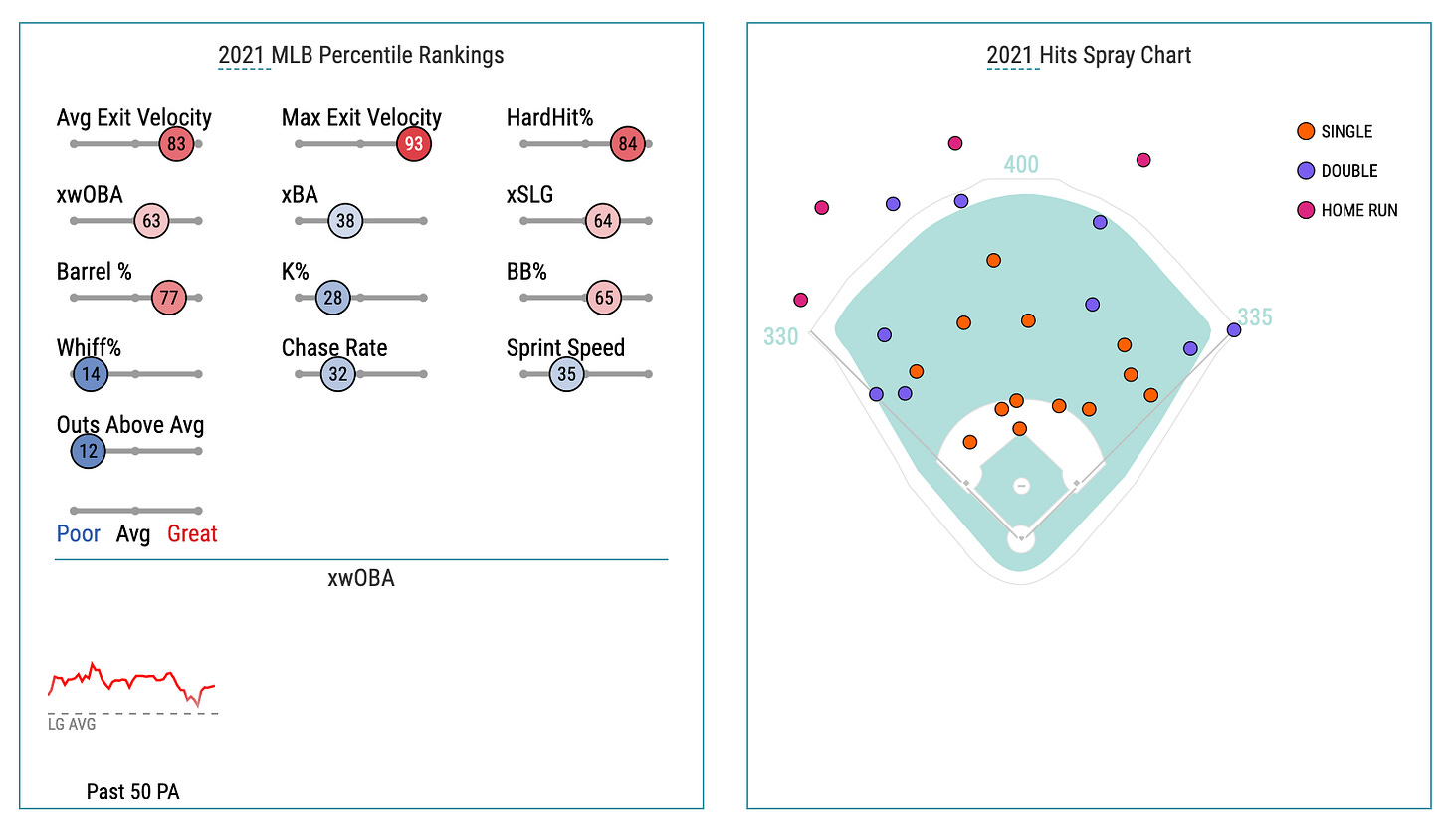

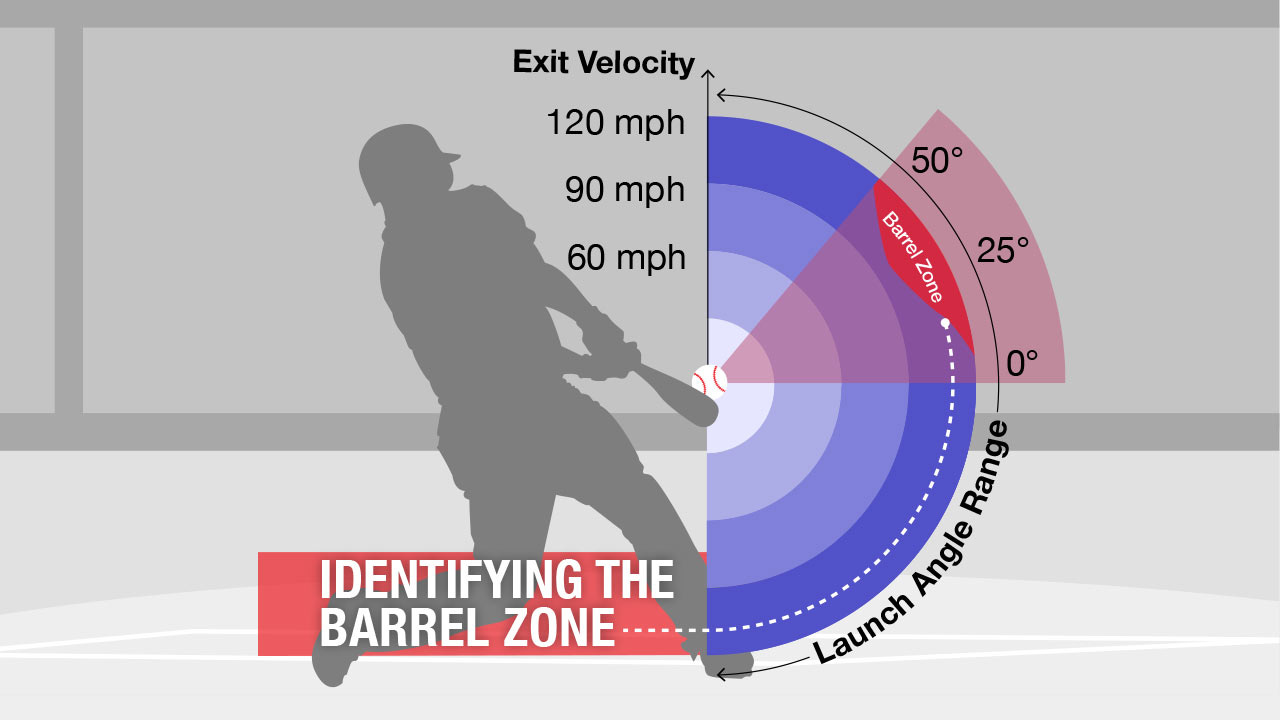
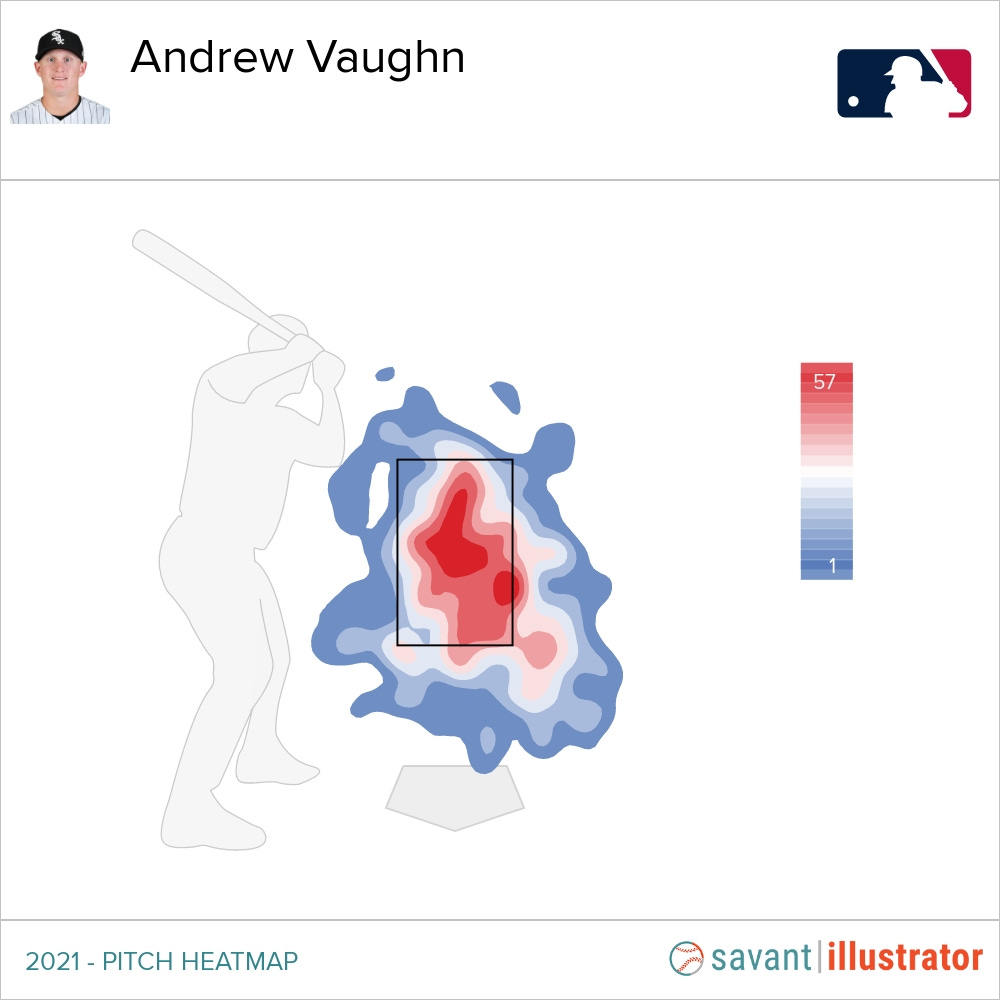


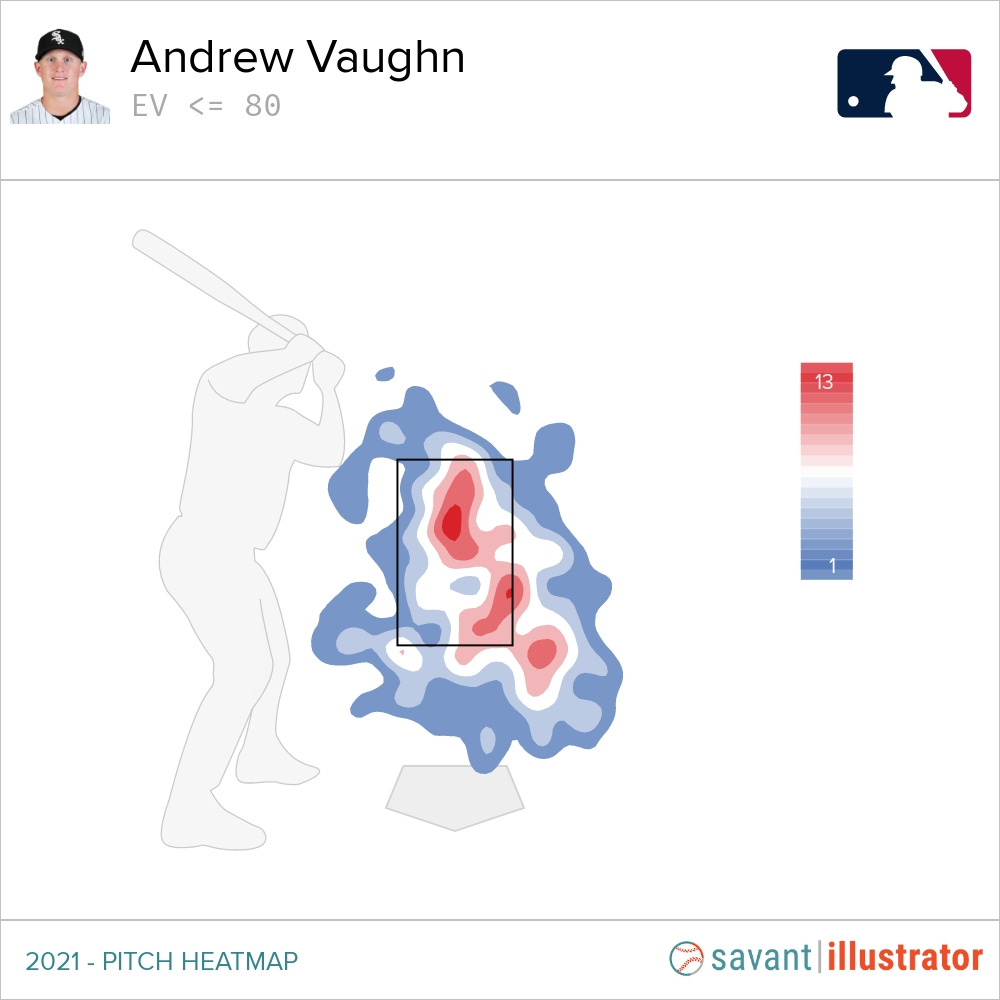
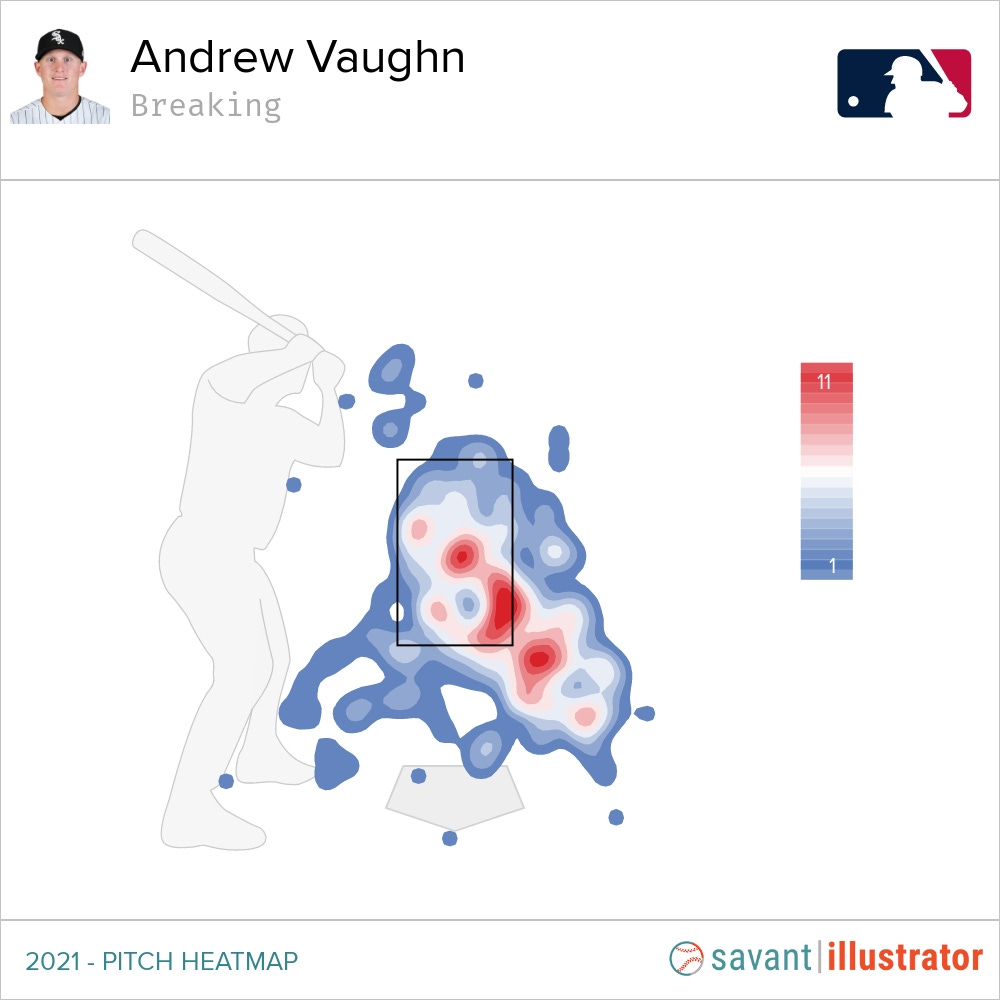


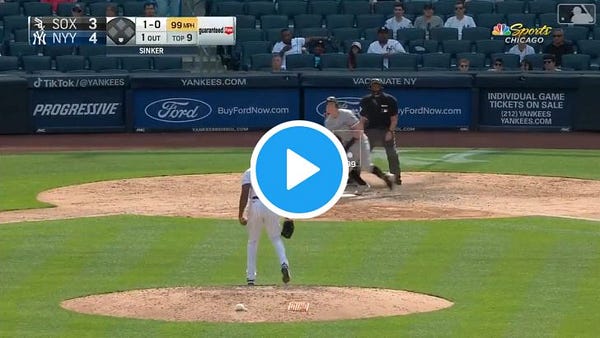

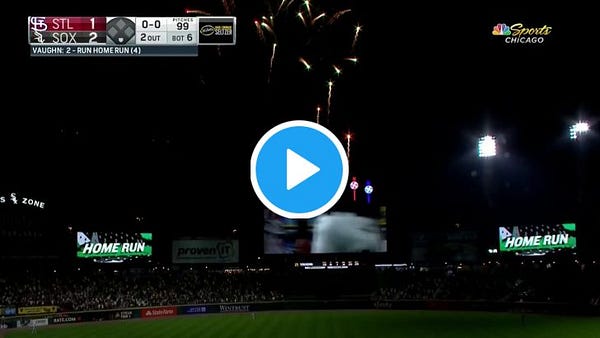

Because Substack is designed for the email newsletter, there is always a limit on the article's length after all the embedded tweets and pictures. I had originally wanted to make a couple of extra points but ran out of space. Still, since his overall MLB performance is already a small data set, any breakdown of that would be on even smaller sample sizes.
With the more advanced analytical focus and the space constriction, I unintentionally left out the following less useful but more traditional note of how Vaughn has scored 18 runs (often pulled for a pinch-runner/defensive replacement when he reaches in the 6th/7th inning) and drove in only 12 guys (RBIs) due to his place. in the White Sox lineup and how Yermin Mercedes can't score from first on a double.
Fantastic work – thank you! Will be great to see how this compares with his actual results at the end of the season. (Hopefully that hot streak starts and never ends.)